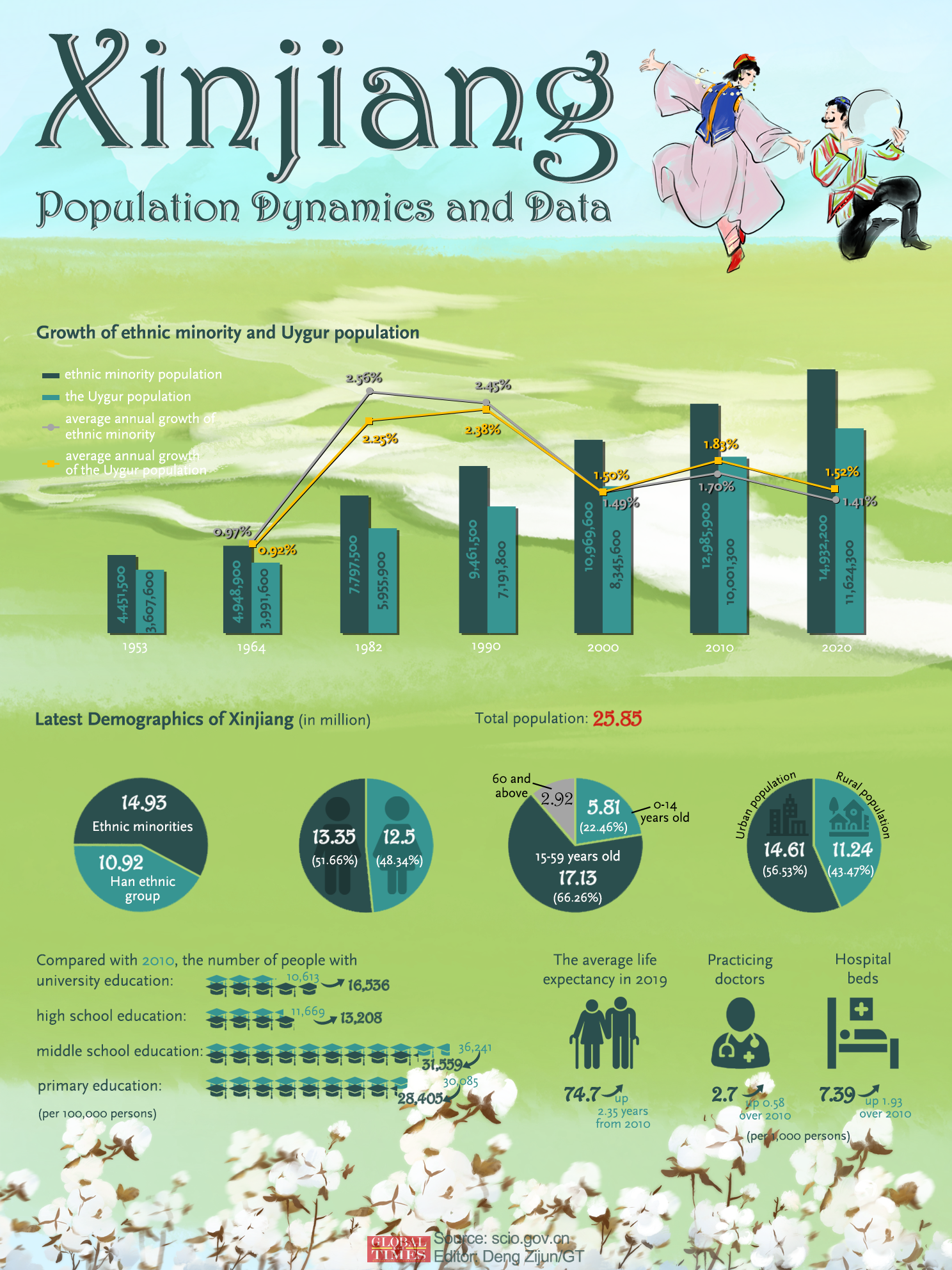China releases first white paper specifically on Xinjiang population
Minority groups’ population rises over 10m in 60 years, refuting West’s hype

The night market in Hami, Xinjiang is filled with customers on July 16, with a young Uygur girl in traditional costumes performing folk dances. Photo: IC
China on Sunday released its first white paper specifically on the population dynamics of its Xinjiang region and by citing data from the seven national censuses, the white paper showed that the population of ethnic minorities in the region has grown fast in both size and quality, with the Uygur population having increased from 3.61 million in 1953 to 11.62 million in 2020, refuting the West's "genocide" accusation with undeniable facts.
Titled "Xinjiang Population Dynamics and Data," it is the first white paper released by the State Council Information Office since 2015 that specifically displays demographic development in Xinjiang for the past seven decades. It is also the 10th white paper released by the office on Xinjiang - previous ones covered human rights achievements, vocational training and education centers, employment and anti-terrorism measures.

Xinjiang Population Dynamics and Data
The white paper contains six parts - population growth in Xinjiang, the latest demographics of the region, demographic changes in the Uygur population, factors contributing to Xinjiang's demographic development, the prospects of the regional population, and falsehoods fabricated by anti-China forces.
The white paper was released against the backdrop of anti-China forces' hyping Xinjiang topics in recent years in an attempt to nail China for the crime of "genocide". The white paper uses solid data and scientific demographic analysis to refute their claims, Li Jianxin, a demographer from Peking University who participated in the drafting of the white paper, told the Global Times.
Data from the white paper showed that the population of Xinjiang, particularly that of its ethnic minorities, has grown fast in both size and quality, and life expectancy has seen a substantial increase. According to preliminary data from the seventh national census in 2020, the total population of Xinjiang was 25.85 million, among which the Han ethnic group numbered 10.92 million, and ethnic minorities 14.93 million. The population of ethnic groups in Xinjiang increased from 4.45 million in 1953 to 14.93 million in 2020.
The Uygur population grew at a compound annual growth rate of 1.67 percent during the first two decades in the 21st century, which was much higher than that of the country's ethnic minority population, which stood at 0.83 percent. The Uygur population grew from 3.61 million in 1953 to more than 11.62 million in 2020. Uygurs accounted for 83.74 percent of the population in the four prefectures in southern Xinjiang.
Previously, some anti-China forces and scholars, for example German "scholar" Adrian Zenz, cited the natural growth rate data on Uygurs from 2017 to 2018, which showed a decline, to say that China is "suppressing" the birth rates of ethnic groups.
These anti-China scholars, who have no professional demographic knowledge, are racking their brains to seek "evidence" for their guilty presumption against China. The demographic situation in Xinjiang, like other places in China and the world, has seen a shift in the trend from high birth and death rates to low birth and death rates, and many factors contributed to the changes, Li said.
One important reason is the social and economic development in Xinjiang, which can be seen from local residents' education levels, especially for females. Li noted that he found in field surveys in southern Xinjiang that previously, girls around 15 years old would graduate from middle school and get married, then give birth to their first, second, and third children. But in recent years, with the increase of education among females, few girls aged 15-19 got married or gave birth.
Data from the white paper echoed Li's remarks. It noted that in Xinjiang, the average years of education for people aged 15 and above rose from 9.27 in 2010 to 10.11 in 2020, 0.2 years higher than the national average of 9.91, and ranking 10th across China. Compared with 2010, the number of people with a university education rose from 10,613 to 16,536 per 100,000 persons.
The change of fertility patterns is the result of development in the fields of education and health, the implementation of laws and de-radicalization. It fits the trend of demographic development and has nothing related to "genocide," said Li.
Xinjiang's measures on anti-terrorism and de-radicalization also help liberate local women with more of them coming out to work and earn money.
With the development of industries in the region, for example, in textiles and apparel, more jobs are offered to women. The wider their horizons become, the more they would decide whether or when to have children, an expert on the economy from Xinjiang University of Finance & Economics, who also joined in drafting the white paper and asked for anonymity, told the Global Times.
The expert noted that this phenomenon fits the laws of economic development. The West, which experienced similar development patterns but now uses the changes of fertility to attack China, is very ridiculous.
"They are not protecting the human rights of ethnic groups in Xinjiang, on the contrary, their sanctions on Xinjiang's cotton and other products hurt the livelihoods of local residents - they are violating Xinjiang residents' human rights!" said the expert.
Different from previous white papers on Xinjiang, the white paper directly refuted some lies by anti-China forces, for example, on "forced labor," "mandatory sterilization" and "cultural genocide."
The Convention on the Prevention and Punishment of the Crime of Genocide, adopted by the UN General Assembly in 1948, provides a clear definition of genocide - acts committed with intent to destroy, in whole or in part, a national, ethnical, racial or religious group. A country can only be convicted of genocide by a competent international judicial institution with proper jurisdiction, in strict accordance with the requirements and procedures stipulated by the relevant conventions and international law.
However, the Chinese government protects the rights of the Uygurs and all other ethnic minority groups in Xinjiang in accordance with the law. This fact stands in sharp contrast to the fabrications by anti-China forces. There has been no forced labor, sterilization or cultural genocide in Xinjiang, said the white paper.
The Chinese government will continue to promote unity, harmony and cultural progress, and strive for a prosperous and eco-friendly Xinjiang, and the region's march toward modernization will not be stopped by any force, and its future is bright and secure, read the white paper.




